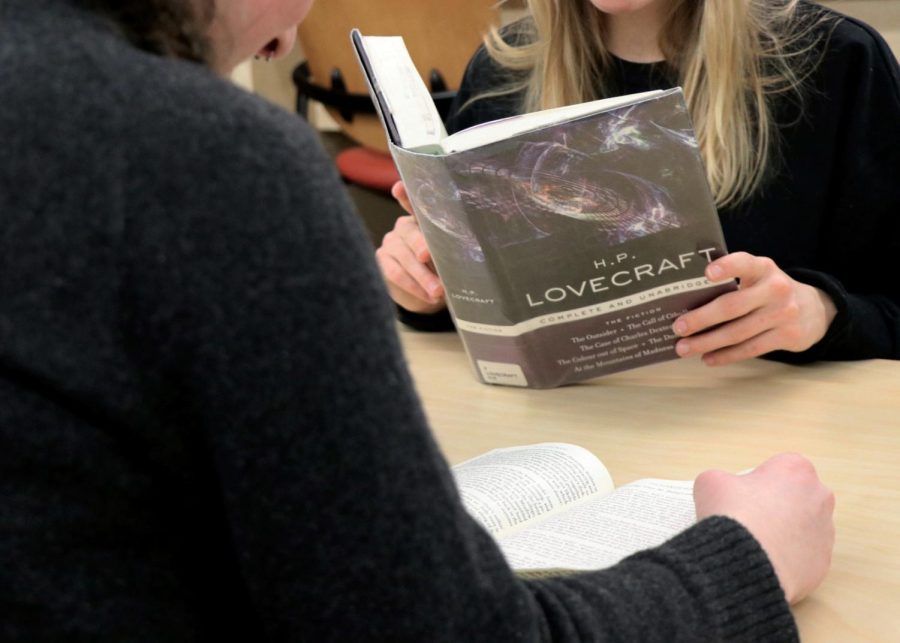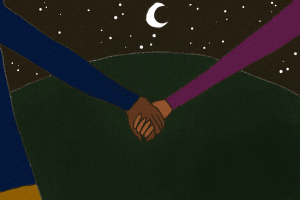Navigating the monstrous mind of a horror writer
Photo Illustration: Burlington has an HP Lovecraft book club that meets every Wednesday in Fletcher Library.
February 9, 2023
With hatred at the heart of one author’s ideas, some readers see his work as a playground instead of a cage.
Burlington’s H.P. Lovecraft Book Club convenes in Fletcher Library every Wednesday to immerse itself in the “Cthulhu Mythos,” a tentacle-filled fictional universe which fans have mapped out using the stories of Howard Phillips Lovecraft, an American horror fiction writer of the early 20th century.
Lovecraft is considered a pioneer of “cosmic horror,” a horror subgenre emphasizing the fragile sanity of humans within a massive, unintelligible universe, according to a July 4, 2017 WhatCulture article.
His style, marked by the fear of the unknown, is woven into modern horror and sci-fi media, including the 1982 film “The Thing,” Japanese manga series “Uzumaki” and Stephen King’s horror novella “The Mist,” according to the WhatCulture article.
Theron Gorman, the club founder and a Burlington local, spoke about the club.
“We do bi-weekly readings, and in between we just meet up to do a writing, drawing, or sculpting prompt,” Gorman said.
Each prompt is a creative exercise in which Gorman reads out a passage by Lovecraft and club members use pen or clay to create a scene however they imagine it, he said.
“We get some really interesting results,” Gorman said.
But as cosmic horror expands into mainstream media, it’s increasingly clear that the fear of an unknown other—Lovecraft’s long-standing trademark—is a metaphor for his xenophobia, particularly towards the influx of immigrants coming to America in the 1920s, according to a May 3, 2019 Areo article.
Lovecraft wrote blatantly racist poetry, expressed affection for Adolf Hitler in letters to friends and threw tantrums while walking through New York’s multiethnic crowds, according to the Areo article.
Lovecraft’s widespread literary influence leaves fans grappling with a beloved stylized genre that remains overshadowed by his own prejudiced fears.
“It’s something that needs to be addressed—Lovecraft was very racist,” Gorman said. “In the club we try to separate the meat from the bones. We can appreciate his art style in horror and try to separate it out from the racism and sexism.”
Lovecraft’s vague descriptions of his creatures makes the unknown all the more horrifying, leaving readers at the mercy of their own imagination, Gorman said.
“He paints around a picture instead of painting the picture,” Gorman said. “That’s what really draws out the unimaginable creations that he’s trying to describe.”
During a prompt, the club uses the ambiguity of Lovecraft’s horror to create their own narratives, interpretations and theories within the Cthulhu Mythos, Gorman said. It allows them to become engrossed by a story while also deviating from any xenophobic intentions.
Despite the racism at the core of cosmic horror, the subgenre continues to gain popularity because Lovecraft’s fear of the unknown resonates with today’s readers on a more existential level.
Gorman said he interprets Lovecraft’s horror as a scientific metaphor, not a racial one.
“He definitely presents this idea that we poke these technological advancements that could be extremely dangerous, and we have no idea,” Gorman said. “We already see that with nuclear technology, for example.”
Anthony Magistrale, a UVM English professor with expertise in American horror, discussed Lovecraft’s fiction as a bridge between 18th century Gothic writing, which featured vampires and ghosts, and early 20th century scientific advancements, including those of physicist Albert Einstein and psychoanalyst Sigmund Freud.
“Lovecraft was trying to take science and connect it to the supernatural phenomenon,” Magistrale said. “That’s where the horror was, in creating a universe that was something someone had to stand in awe in front of.”
As readers redefine the fear of the unknown, modern cosmic horror writers seek to take the racist concepts fused into Lovecraft’s fiction and turn them on their heads, often centering Black characters who had previously been the metaphorical villains of such stories.
Author Victor LaValle’s “The Ballad of Black Tom” re-tells a Lovecraft story from the perspective of a Black man, while Matt Ruff’s novel, “Lovecraft Country,” incorporates Lovecraftian monsters into America’s Jim Crow era, inspiring an HBO spin-off series of the same name, according to an Aug. 18, 2020 Vox article.
In “Mexican Gothic,” author Silvia Moreno-Garcia flips the script on Lovecraft’s themes of impure bloodlines and hereditary evil to tell a story about racism, eugenics and heritage, according to a Jan. 22, 2021 CBC article.
Inviting readers to imagine the unimaginable, Lovecraft tapped into an existential terror that continues to resonate almost a century after his death in 1937.
In deconstructing, redefining, expanding, criticizing and appreciating what Lovecraft brings to the table, horror writers and fans adapt the timeless fear of the unknown into new stories that open people’s minds, not close them.







